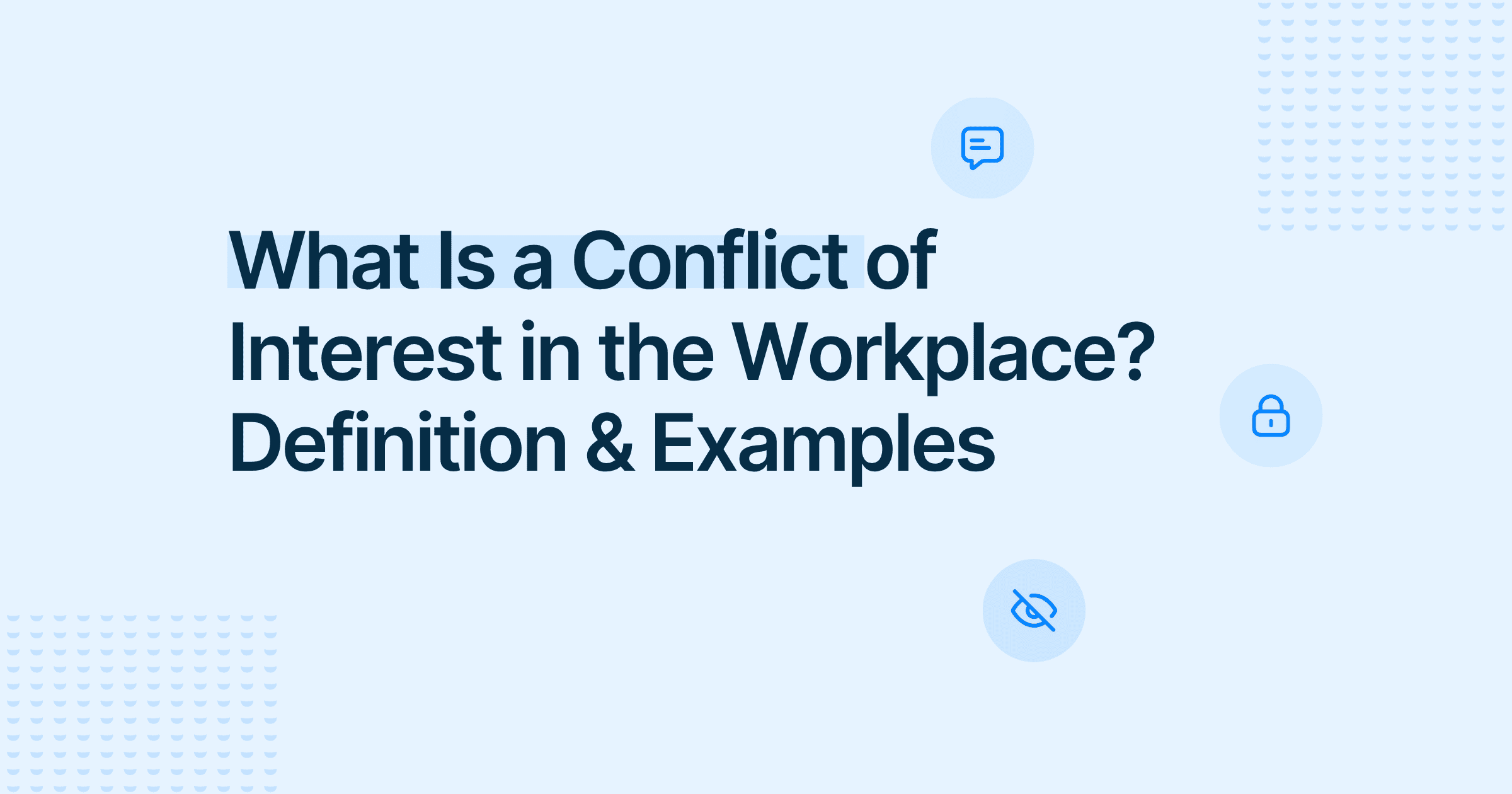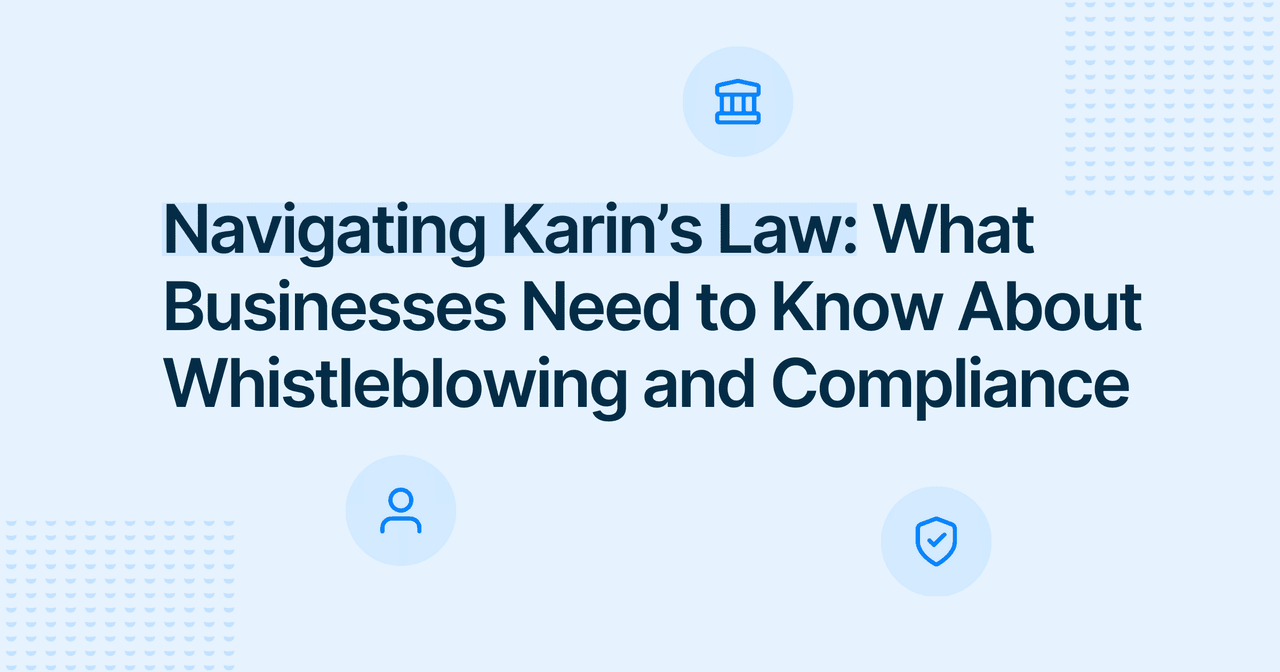



Discover the benefits of a transparent organization!
Try our free platform and strengthen the culture of openness in your team.
Workplace Environment

Yeva Bartkiv
Copywriter
Published
2025-06-23
Reading time
7 min


Table of contents
Subscribe to our newsletter
If you’ve ever had to stop and consider whether your personal connections or outside involvement may be clouding your judgment at work, we’ve got good news. First, you’re not alone. Second, you’ve got a good feel for potential conflicts of interest in the workplace.
Conflicts of interest aren’t just abstract HR or legal concepts. They’re real, everyday situations that can make good people feel stuck between doing what’s right and what feels familiar. And they can cause real problems.
Whether you're in HR, a team lead, or an employee who wants to stay aligned with your values, understanding and managing conflicts of interest is critical to maintaining trust, fairness, and ethical standards across your organization.

In this guide, we’ll break down what a conflict of interest actually looks like, explore the types of conflicts of interest, and help you identify when personal interests may be quietly shaping your choices.
Most importantly, we’ll give you the tools to handle these situations with confidence and integrity. So, you better keep reading!
A conflict of interest happens when your personal interests - whether emotional, relational, or financial - interfere with your ability to make unbiased, ethical choices at work.
These aren’t always black-and-white moments. Sometimes, a conflict isn’t obvious until someone else points it out - and by then, trust may already be eroding. There are three major categories to be aware of:
These conflicts can damage relationships, stall promotions, and even lead to legal action. Often, the biggest damage isn't from what was done, but how it was hidden, denied, or mishandled.
Conflicts of interest don’t just impact big corporations in courtroom dramas. They shape everyday choices in meetings, emails, performance reviews, and hiring decisions. Ignoring them puts you, your team, and your entire company at risk. Here's how:
Maybe you're concerned about promoting a close friend, or you’ve been offered a side gig from a client. These aren't hypothetical. They're the kind of questions you're expected to handle - often without much guidance.

Understanding the types of conflict of interest in the workplace helps you spot trouble before it starts.
Say you have financial interests in a vendor or competitor. Even if you’re not actively benefiting, your professional decisions might be influenced - or appear to be. These situations often lead to self-dealing or, in extreme cases, insider trading.
Balancing a full-time job while doing freelance work for competing businesses is tricky. Even if you feel you can juggle it, your loyalty might come into question. These are competing interests, and they matter.
Workplace romantic relationships aren't uncommon. But when a romantic partner or family member reports to you, or you’re making decisions about their pay, it’s a conflict. Even if you’re acting fairly, others may see preferential treatment.

Hiring or promoting a family member can seem harmless, especially if they’re qualified. But unless it’s fully transparent and reviewed independently, nepotism can create resentment and harm morale.
Receiving an expensive gift or an all-expenses-paid trip from a vendor feels flattering, but it can create an expectation. It might not be financial gain, but it’s still an influence. Many code of conduct policies prohibit this for good reason.
You learn something in a strategy meeting and share it with a friend who's invested in the industry. This might seem innocent, but sharing confidential information can lead to accusations of insider trading, even if you didn’t benefit directly.
Serving as a board member or advisor for another organization is rewarding - unless that group does business with your employer. Then, it becomes one of those potential conflicts of interest you need to disclose and manage.
If you’ve ever thought:
You’re not alone. But these thoughts could be early signs of a conflict of interest. The most damaging conflicts aren’t the most obvious - they’re the ones we justify to ourselves.
Let’s look at common examples to make this more concrete.
Hiring a Relative
You’re in a position to recommend or hire, and a family member applies. Do you let someone else review the application? If not, this creates the perception, or reality, of nepotism.
Promoting Someone You’re Dating
You’re dating a coworker, and they’re up for a raise. Can you stay unbiased? Will others think you’ve been fair? This is a classic conflict of interest dating in the workplace scenario.
Choosing a Friend’s Business
You help pick vendors, and your close friend owns one. If you don’t open it up for bids or disclose your connection, it may look like preferential treatment, even if their price is the best.
Taking on a Side Gig
You take freelance work that overlaps with your employer’s client base. This could breach your non-compete agreement and impact your employer’s business - and your job security.

A conflict of interest policy is not just a legal document. It's your organization's safety net - a clear, practical guide that helps people like you navigate gray areas.
A good policy includes:
The goal is not to punish people. It's to create clear policies that help everyone make smart, ethical decisions without second-guessing themselves.
Ethics training isn’t about checking boxes. Done right, it offers relatable stories, examples of conflict of interest in the workplace, and guidance that connects with the real challenges you face.
People avoid reporting issues because they fear judgment or retaliation. Change that. Normalize disclosure. Make it part of onboarding, reviews, and professional judgment conversations.
If you’re too close to a decision, step back. Whether it involves a romantic partner or financial interests, being willing to recuse yourself builds credibility and avoids doubts.
Use a multi-person review process for hiring, procurement, and bonuses. Not because you don’t trust people, but because checks and balances protect everyone involved.
Rules mean little without consequences. If someone breaks the conflict of interest policy in the workplace, investigate fairly and act consistently.
Avoiding conflicts doesn’t mean cutting off all relationships or tiptoeing around every decision. It means being aware and proactive.
Leaders set the tone. When board members and executives model transparency, it becomes easier for everyone else to follow.
Support systems like anonymous reporting, safe conversations with HR, and ethical leadership make dealing with conflict of interest in the workplace feel less like a risk and more like part of healthy dialogue.
A conflict of interest in the workplace is ultimately about trust. Trust in leadership. Trust in fairness. Trust that everyone, regardless of relationships or roles, will be treated with integrity.
You don’t have to be perfect. You just have to be honest. If something feels off, say something. And if you’re in doubt, ask yourself: would I feel comfortable explaining this to my team, my boss, or in public?
That question alone can help you avoid conflicts of interest - and build a stronger, more ethical place to work.
Start today. Review your conflict of interest policy, revisit your ethics training, and create space for the conversations that matter.




Try our free platform and strengthen the culture of openness in your team.
Keep Reading

Alaa El-Shaarawi2025-12-197 min
Workplace Environment

Marie Roland2025-12-165 min
Whistleblowing

Alaa El-Shaarawi2025-12-087 min
Workplace Environment